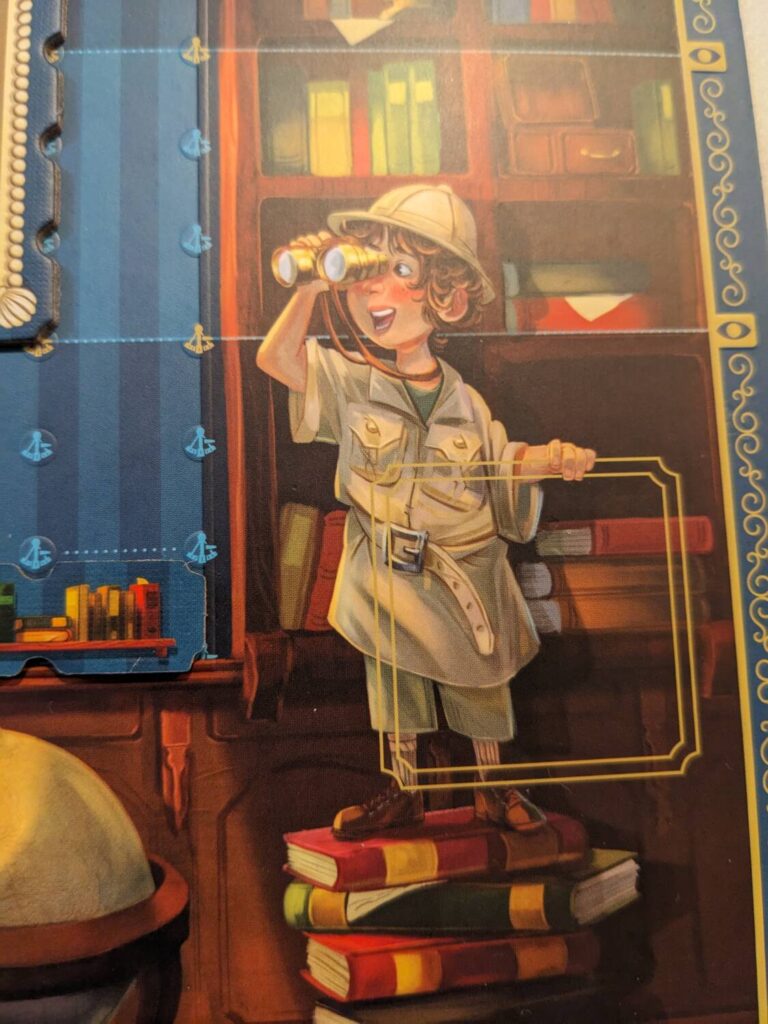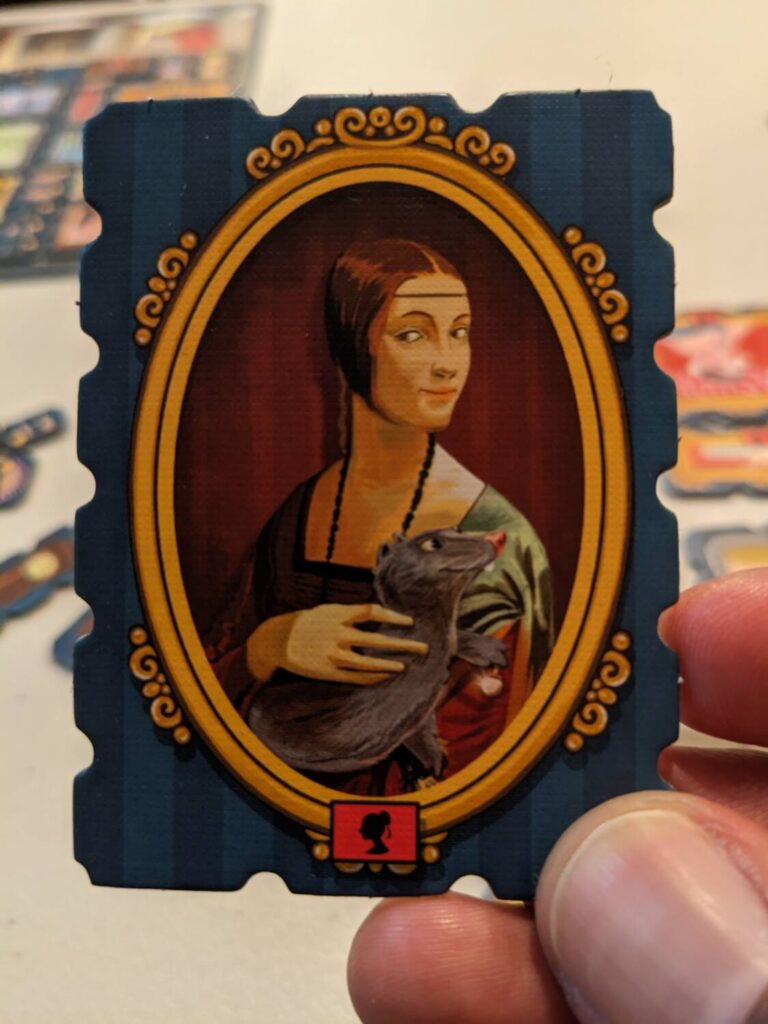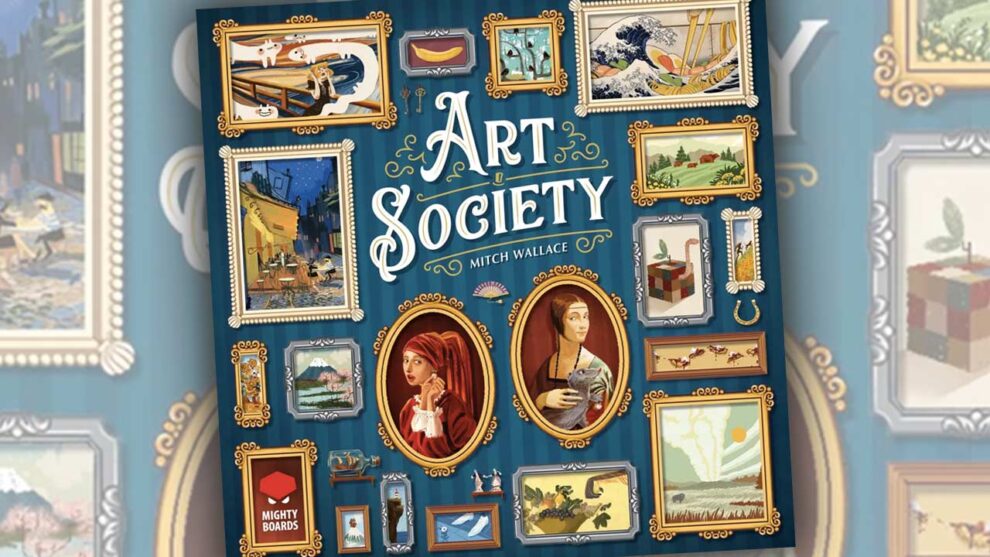Disclosure: Meeple Mountain received a free copy of this product in exchange for an honest, unbiased review. This review is not intended to be an endorsement.
Mighty Boards has delivered a number of “bangers” for the Meeple Mountain team over the last few years. I personally had the chance to cover Vengeance: Roll & Fight–Episode 2, and my colleague Bob had great things to say about Petrichor. Both of us have spent quality time with David Chircop, the co-founder and lead designer at Mighty Boards, who also designed last year’s village building game, Hamlet.
The publisher was kind enough to provide me with their latest release, Art Society, at SPIEL 2023, and the buzz was great for the game throughout the show. Now that I’ve had the chance to get the game to my table a few times, I see why that was the case. Art Society is a light tile-laying design with the kind of mass appeal that should draw attention from almost any gaming group and hobbyists looking to draw new recruits to this space.

Your Decor is Handsome
Art Society is one of the rare games this year where I got in a set of “perfect” review plays. I played it once at all player counts (so, three games, at two, three, and four players) with completely different players in each of those games to provide me with a fantastic array of perspectives on the game.
That means that six other people joined me for my plays, and the seven of us collectively came away thinking the same thing. If you like tile placement games, Art Society is for you. If you like bidding games, Art Society should be a fit. If you like games that can be taught in less than ten minutes and played in about an hour, Art Society is a winner. If you like interactive games, Art Society is hard to beat given its weight class, thanks to its tile drafting system that doubles as a “hate drafting” system depending on who’s sitting at the table.
What made the game work for all of us? It starts with the game’s simple theme. Players take on the roles of art collectors, trying to build the best-looking wall of pictures that are conveniently sized to accommodate a simple series of square and rectangular tiles. (That’s right—no funky triangles, Tetris-style L or T-shaped polyomino tiles, etc.)
On a turn, players must play one of their 20 bidding cards (produced to look like auction paddles). The person who played the highest bidding card gets to draft one of the tiles that was selected from a tile pool by the active player in that round, with ties settled by the higher number bid during the previous round. The number of tiles—equal to the player count plus one—means that all players will always have at least two tiles to choose from.
Paintings come in sizes ranging from a value of three, to a value of nine, with the nine-value tiles taking up much more real estate. Each painting tile comes in four distinct types: City Life, Portrait, Still Life, and Landscape. The only three major rules/advice for placing tiles on your personal player board: each new tile must be orthogonally adjacent to any other tile, like painting types should not be touching (because this creates a “faux pas”, which negates the score for all matching types that are connected), and the frame style of each painting matters. In this way, the rules of Art Society closely mirror the guidance in the recent Peter McPherson title Fit to Print.

That last point is important, because if you can find disparate painting types that also have matching frame types, you get a Decor bonus. For each frame that now touches the newest addition to your collection, you can add small pieces of flair to your board…which really means you can fill out nooks and crannies on your board that were created when placing other pieces of art during play.
So, this rule of thumb—”matching frames are good, matching painting types are bad”—makes the teach really easy for this game.
Art Society is a friendly affair, so if you are ever forced to draft a painting you can’t place (or simply don’t want to), your assistant can hold one item for later. This storage area becomes crucial late in a game, when players are running tight on space.
Oh, right…what happens to the undrafted piece of art? That is used to boost the value of the painting type that was left over by a number of points equal to the size of that painting.
The end of play is triggered when someone completely fills their player board with art, or if two paintings are set aside and can’t be placed or held by that player’s assistant. (Games can also end if all 20 bidding rounds happen, but that didn’t happen during my three review plays.)
At the end of the game, painting types are ranked based on a score track, and the most valuable painting type is then worth five times the number of that type in your finished tableau, assuming it is not a part of a faux pas. Second place equals four times the number of that type, and so on. Additional bonuses arrive in the form of points for Decor, points for a completely full grid on a player board, and points that are subtracted for paintings that are drafted but unplaced.

Lighter Fare That Fits for All
Art Society fits for all of the audiences in my scope, and I have a feeling that it would fit for everyone you play games with, too. Further, it is inviting enough to try this with people who don’t fit the description of a hobbyist. Try this with Grandma Myrtle over the holidays, and it’s probably going to work out.
Art Society’s biggest issue: player count. Art Society at two players was fine, and nothing more than that. The bidding cycles with only one opponent are often boring, because players are probably going to play low bidding cards since they know they will get a choice from two of the three available tiles each turn. Of my three plays, the two-player game was the least interesting.
At higher player counts, Art Society delivered maximum fun. Give this a look if tile-laying masterworks are a fit for you!












Not a theme I would have thought would grab my attention. But your review made it happen.
I will have to see if I can give this one a try soon.